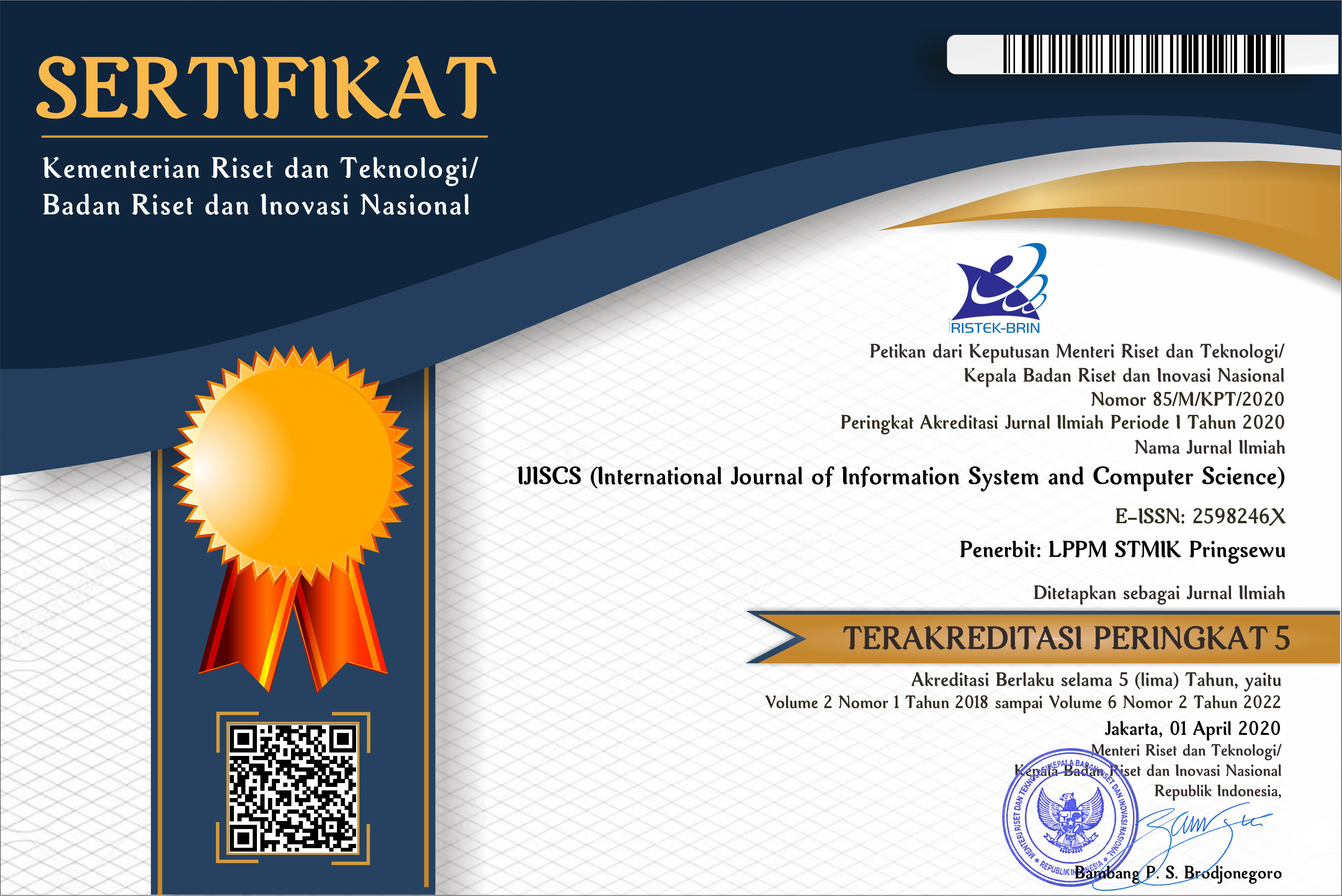MODELING OF AN ADAPTIVE E-LEARNING SYSTEM FOR IMPROVED LEARNING PERFORMANCE
(1) Federal University of Technology Akure, Nigeria
(2) Federal University of Technology Akure
(3) Federal University of Technology Akure
(4) Federal University of Technology Akure
 Corresponding Author
Corresponding Author
Abstract
Majority of the online learning systems in use today, lack proper integration of adaptive, collaborative, personalized and ubiquitous concepts in their design and implementation. Integration of these basic concepts in online learning systems will enable adaptation, individualization, and collaboration of learning resources to learners’ preferences, with an added advantage of accessibility to online resources anywhere and anytime. Hence, the research proposes an Adaptive E-Learning System (AES) model that incorporates activities sequencing in a personalised, adaptive, collaborative and ubiquitous learning environment. The system model consists of the system (software) architectural diagram and mathematical model of activity sequence. The design is presented using the UML activity diagram and the class diagram. The full implementation of the system is currently being carried out and is being tested with real life cases.
Keywords
References
Anonymous (2017), Activity Sequence Modelling for Effective Collaboration in an U-Learning System, in Proceedings of the 11th International Multi-Conference on ICT Applications (AICTTRA 2017) Vol. XI; at Obafemi Awolowo University Ile- Ife, Nigeria, 1– 4 November, pp. 67 – 74. Available at: https://www.researchgate.net/publication/322662890_MODELLING_OF_ACTIVITY_SEQUENCE_IN_A_PERSONALIZED_ADAPTIVE_UBIQUITOUS_LEARNING_SYSTEM
Anonymous (2015) ‘A Cognitive Load Theory-Based Framework for Designing an E-Learning Environment’, African Journal. of Comp & ICTs. 8(3) [online]. Available at: https://afrjcict.net/wp-content/uploads/2017/08/vol-8-no-3-sept-2015ppi-245.pdf (Accessed: 1 October 2019)
Ahmed, E.R. (2006) Introduction to GPS: The global positioning system, Second edition. Boston MA: Artech House Publishers,
Almohammadi, K. & Hagras, H. (2013) ‘An Interval Type-2 Fuzzy Logic Based System for Customised Knowledge Delivery within Pervasive E-Learning Platforms’, Proceeding of IEEE International Conference on Systems. Man, Cybernetics, p2872-2879
Andharini, D. C., Ari, B., Eka, M. S. & Yeni, K. (2015) ‘An adaptive e-learning application architecture based on IEEE LTSA reference model’, TELKOMNIKA, 13(1) [online]. Available at: DOI: 10.12928/TELKOMNIKA.v13i1.112 (Accessed: 15 March 2020)
Bachari, E. E., Abdelwahed, E. & Adnani, M. E. (2010) ‘Design of an adaptive e-learning model based on learner’s personality’, Ubiquitous Computing and Communication Journal, 5(3), p1-8.
Calimag, J. N., Mugel, P. A., Conde, R. S. & Aquino, L. B. (2014) ‘Ubquitous learning environment using android mobile application’, International Journal of Research in Engineering & Technology, 2(2) [online]. Available at:
https://citeseerx.ist.psu.edu/viewdoc/download?doi=10.1.1.681.508&rep=rep1&type=pdf
Chu, H., Hwang, G. & and Tsai, C. (2010) ‘A knowledge engineering approach to developing mindtools for context-aware ubiquitous learning’, Journal Computers & Education, 54(1), p289-297
Dey, A.K. (2000) ‘Providing architectural support for building context-aware applications’. PhD Thesis. Georgia Institute of Technology, USA,
Doukhnitch E., Salamah M. & Ozen E. (2008) ‘An efficient approach for trilateration in 3D positioning’, Computer Communications, 31(17) [online]. Available at:
https://doi.org/10.1016/j.comcom.2008.08.019
Felder, R. M. & Silverman, L. K. (1988) ‘Learning Styles and Teaching Styles in Engineering Education’, Journal of Engineering Education, 78(7), p674-681.
Hwang, G. H., Chen, B., Chu, H. C. & Cheng, Z. S. (2012) ‘Development of a Web 2.0-based ubiquitous learning platform for schoolyard plant identification’, Proceeding of IEEE International Conference on Wireless, Mobile, and Ubiquitous Technology in Education, Japan, p259-263
Kupper, A. (2005) ‘Location-based services: Fundamentals and operation’, Wiley, Chichester, p1-14, p123-154.
Ogata, H., & Yano, Y. (2004) ‘Context-aware support for computer supported ubiquitous learning’, Proceedings of the Second IEEE International Workshop on Wireless and Mobile Technologies in Education. Los Alamitos: IEEE Computer Society, p27–34.
Pham, Q. D. & Adina, M. F. (2013) ‘An Adaptation to learners’ learning styles in a multi agent e-learning system’, Internet Learning, 2(1) [online]. Available at: https://ipsonet.org/sin-categoria/volume-2-number-1-spring-2013/
Rikala, J. & Kankaanranta, M. (2012) ‘The Use of Quick Response Codes in the Classroom’, [online]. Available at: http://ceur-ws.org/Vol-955/papers/paper_40.pdf on 14/09/2017
Rodrigues, J. J., Sousa, D. V. & Torre, I. (2012) ‘A Mobile Learning Content-independent Versatile Ubiquitous System (CiVUS)’, Learning with Mobile Technologies, Handheld Devices, and Smart Phones: Innovative Methods, 21-36.
Rogers, Y., Price, S., Randell, C., Stanton, F. D., Weal, M. & Fitzpatrick, G. (2005) ‘Ubi-learning integrates indoor and outdoor experiences’, Communications of the ACM, 48(1), [online]. Available at: https://dl.acm.org/doi/abs/10.1145/1039539.1039570
Ruiz D., Ureña J., García J.C., Villadangos J.M., Pérez M.C. & García E. (2013) ‘Efficient Trilateration Algorithm using Differences of Time of Arrival’, Sens. Actuators A Phys.;193 [online]. Available at: doi: 10.1016/j.sna.2012.12.021.
Sadoun, B. & Al-Bayari, O. (2007) ‘Location based services using geographical information systems’, Computer Communications, 30(16) [online]. Available at:
https://doi.org/10.1016/j.comcom.2007.05.059
Setiya, R. & Gaur, A. (2012) ‘Location fingerprinting of mobile terminals by using Wi-Fi device’, International Journal of Advanced Research in Computer Engineering & Technology, 1(4), [online]. Available at: http://ijarcet.org/wp-content/uploads/IJARCET-VOL-1-ISSUE-4-311-314.pdf
Stylios, C. D. & Groumpos, P. P. (1999) ‘Mathematical Formulation of Fuzzy Cognitive Maps’, Proceedings of the 7th Mediterranean Conference on Control and Automation (MED99), p2251-2261.
Sweta, S, & Lal, K. (2016) ‘Learner Model for Automatic Detection of Learning Style Using FCM in Adaptive E-Learning System’, IOSR Journal of Computer Engineering, 1(18) [online]. Available at: https://www.iosrjournals.org/iosr-jce/papers/Vol18-issue2/Version-4/C1802041824.pdf
Tummala, H. & Jones, J. (2005) ‘Developing spatially-aware content management systems for dynamic, location-specific information in mobile environments’, The 3rd ACM International Workshop on Wireless Mobile Applications and Services on WLAN Hotspots [online]. Available at: https://doi.org/10.1145/1080730.1080733
Wang, Y.K. (2004) ‘Context awareness and adaptation in mobile learning’, Proceeding of The 2nd IEEE International Workshop on Wireless and Mobile Technologies in Education (WMTE’04), p154–158.
Wilkerson, M., Griswold, W. & Simon, B. (2005) ‘Ubiquitous presenter: Increasing student access and control in a digital lecturing environment’, The 36th SIGCSE Technical Symposium on Computer Science Education, [online]. Available at: https://dl.acm.org/doi/10.1145/1047344.1047394
Yang, S. J. (2006) ‘Context Aware Ubiquitous Learning Environments for Peer-to-Peer Collaborative Learning’, Educational Technology & Society, 9 (1) [online]. Available at: http://www.ifets.info/journals/9_1/16.pdf
Zhao, X., Anma, F., Ninomiya, T. & Okamoto, T. (2008) ‘Personalized Adaptive Content System for Context-Aware Mobile Learning’, International Journal of Computer Science and Network Security (IJCSNS), 8(8) [online]. Available at: http://paper.ijcsns.org/07_book/200808/20080823.pdf
Article Metrics
Abstract View : 33 times
: 33 times Download : 10 times
Download : 10 times
DOI: 10.56327/ijiscs.v7i1.1422
Refbacks
- There are currently no refbacks.






